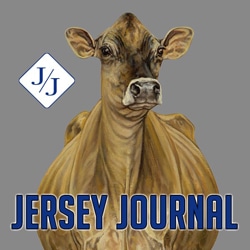Dairy Profitability Starts with a Roadmap
Creative, out-of-the-box and innovative are optimistic words one might use to describe the way dairy producers have managed finances in recent years. After years of low milk prices, many dairy producers have changed the way they do business and altered their mindset to continue milking cows for a living. The silver lining in this storm cloud? There is light at the end of the tunnel and measures they took to survive will position dairy producers to capitalize while milk prices are improving.
So, what does a financial adviser recommend for this challenging dairy environment? What can dairy producers do today to better their fiscal situation down the road?
“First, look at your financial picture from a broad, overall perspective to see whether you are converting variable inputs into profitability and using fixed costs efficiently,” said John Lehr, a farm business consultant with 30 years of experience and now vice president of Farm Credit East in Cooperstown, N.Y. “Then use a looking glass to compare performance of your farm to your peers for key benchmarks. Identify limiting factors, strengths and opportunities for improvement. From here, develop a ‘no excuses’ action plan and make sure everyone on your team adheres to it.”
Lehr and his dairy business team at Farm Credit help their clients develop action plans by evaluating their five-line earnings analysis (the broad perspective) in conjunction with five key areas of profitability (the looking glass). Their benchmarks have been developed by analyzing accrual earning statements, balance sheets and production information from more than 130 dairy farms in the Northeast representing 150,000 cows.

Lehr himself works with more than 50 dairy herds in New York, representing more than 55,000 cows. Four are all-Jersey herds; several are Holstein operations adding Jerseys. Lehr also operates Ky-Hi Jerseys in Canastota, N.Y., with his wife, Lynda, and children, Kylie and Dylan.
Five-Line Earnings Analysis
Most business owners are familiar with the five-line earnings analysis. It is the basis for profitability. And though you probably have a pretty good idea where you stand with this, it is worthwhile to plug in the numbers on an annual basis.
Gross margin reflects whether a dairy is converting variable inputs, like labor, feed and crops, into milk profitability. Looking at fixed costs separately allows a dairy to determine whether it is using fixed costs, like facilities, efficiently.
Five Keys to Profit
The “five keys to profit” that the Farm Credit group developed are gross sales, production efficiency, capacity, industry skills and cost control. First determine the value for each key, then evaluate your performance as compared to your peers.
When you compare your numbers to your benchmark peer group, you have a powerful analysis that shows you where to focus to improve profits.
Gross Sales
• Measured by gross sales per cow
• Are you producing the most component pounds per cow you can?
• Are you maximizing price by capitalizing on components, milk quality premiums and other?
• Have you explored income diversity, like marketing herd genetics or excess crops?
“Take a look at everything that maximizes gross sales per cow,” noted Lehr.
“Fans and cooling are big contributors here. Make sure you have enough fans and are providing adequate cooling to prevent heat stress.”
“As well, make sure you have adequate forage inventory, so you won’t be forced to feed green feed, which negatively impacts milk yield and components.”
Production Efficiency
• Measured by gross margin per cow
• Are you utilizing labor efficiently as measured by component pounds sold per worker?
• Are you maximizing forage quality to minimize feed cost?
• Are your crop costs in line on a per-acre or per-ton basis?
“Because feed for heifers is a major drain on finances and feed inventory, a key question to ask is, ‘Are we feeding too many heifers?’”
“Find the ideal number and raise only the heifers you’ll need. If you sell bred heifers as replacements or beef, make sure you can recoup their costs.”
Capacity
• Measured by overhead or fixed cost per cow
• Are you using your facilities and resources to their potential? Consider land, parlor, machinery, dairy facility and others.
• Are your resources in balance? For example, do you have too much equipment for herd size?
“You might have to think out of the box to become efficient for capacity. Consider practices that might not be obvious initially. For example, are we renting some poor land that we should just let go? Should we hire a custom operator to haul manure?”
Industry Skills
• Measured by cull rate, pregnancy rates, forage quality, slippage rate, total components shipped per cow and others
• Are you capitalizing on your strengths and improving your weaknesses?
“Benchmarks can help you address industry standards like cull and pregnancy rates. But it can be difficult to assess strengths and weaknesses of your operation. Consider setting up an advisory or peer group meeting to gain an outside perspective. As well, in some parts of the country, DHI provides reports with benchmarks to help with herd management.”
Cost Control
• Measured by your net cost of production and breakeven milk price
• Have you created an internal culture of ‘every dollar earned is yours to keep?’
• Are you actively price shopping, managing inventory and limiting shrink?
“Debt structure is a key component to your breakeven milk price. Make sure you have the appropriate debt structure, a payment period that is neither too long nor too short.”
No Excuse Action Plan
Developing an action plan to improve profit with realistic, deliverable goals takes time, effort and follow through. A “no excuses action plan” is powerful once your entire team is on board.
Advisory groups and peer groups can help you evaluate benchmarks, isolate areas to improve and establish goals. Develop partial budgets to test payback viability and fine tune your plan.
“Sure, it takes effort to develop an action plan for your dairy. But when one is in place and your entire team is on board, your operation will be firing on all cylinders,” summed Lehr.
Producer Perspectives
For producer tips during challenging financial times, subscribe to the Jersey Journal and read the sidebar that accompanies this article in the December 2019 issue.




